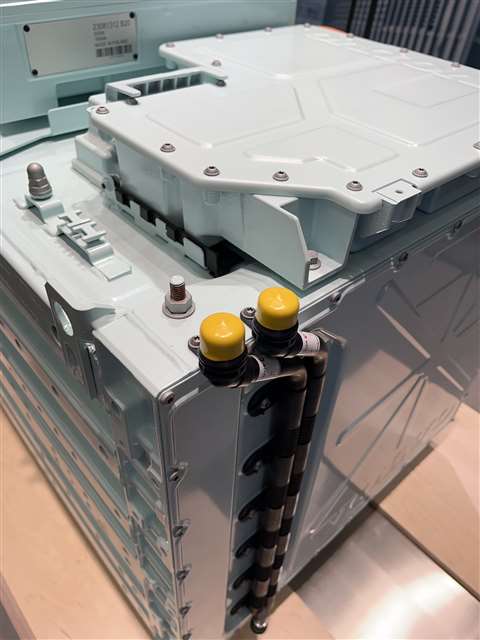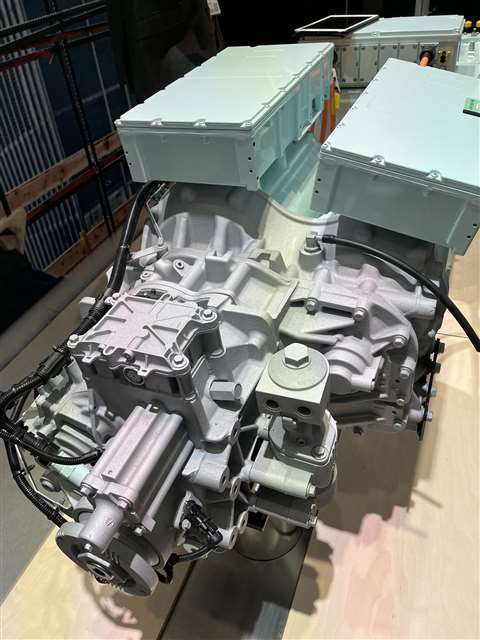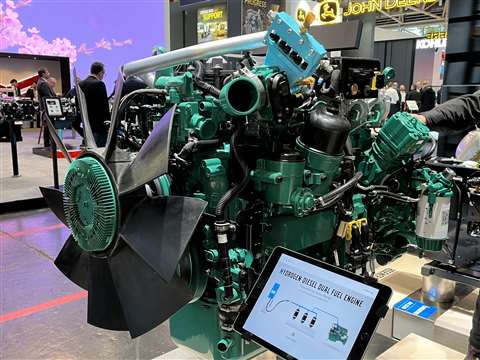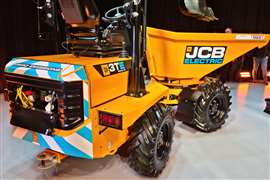Volvo Penta takes parallel paths to alternative power
14 November 2022
Given the vast array of applications and requirements in the industrial sector, power system suppliers must hedge their bets when it comes to the alternatives that can help customers achieve carbon neutrality objectives. Volvo Group is no exception.
The company has chosen to follow three different technology paths in parallel, said Prabhakaran Sundaramurthi, vice president, product management – Industrial Business Unit, Volvo Penta, including battery-electric and hybrid systems, alternative fuel-based internal combustion engines and hydrogen fuel cells.
“On top of this, we also need to adapt these solutions to our customers, because we have a wide variety of applications, a large number of OEMs. So, we have to meet the individual requirements,” Sundaramurthi said. “Most importantly, we have to be technology agnostic, because there is no one solution that will meet all the needs.”
 The cube battery can be easily stacked to deliver more energy density. The electric platform shown has a nominal voltage of 600 V. (Photo: Diesel Progress staff)
The cube battery can be easily stacked to deliver more energy density. The electric platform shown has a nominal voltage of 600 V. (Photo: Diesel Progress staff)
New steps along these paths were featured in the Volvo Penta booth at Bauma 2022, including a new battery configuration that expands the company’s electromobility offering as well as a dual-fuel hydrogen engine pilot project.
Electromobility takes new shape
The cube battery joins Volvo Penta’s existing flat-pack battery to provide installation flexibility for OEMs seeking to electrify vehicles and equipment. The cube battery, which derives its name from its physical shape, measures 768mm x 684 mm x 668 mm.
“This system can deliver 90 kW hours of energy. The cells are grouped together into modules, which make up the battery pack,” said Sundaramurthi. The cube battery provides 173 kW peak power and 99 kW continuous power, while the flat-pack battery, which is rated 94 kWh of energy, provides 97 kW peak power and 91 kW continuous power.
The cube battery can be easily stacked to deliver more energy density. The electric platform shown at Bauma featured a nominal voltage of 600 V and included the battery pack, two electric motors rated up to 200 kW, the battery management system, gearbox, inverters, junction box and high-voltage cables – all packaged as a system.
“Volvo Penta is taking a system solution supplier approach,” Sundaramurthi explained. “We not only supply the batteries but on top of that varying degrees of motors in different combinations; gearboxes; active cooling units and compressors if you want to use it for brakes; inverters; onboard chargers; high-voltage cables; junction boxes; and different types of control units. We do this to secure consistent performance during the lifespan, as well as to secure the desired reliability and durability and, most importantly, safety.”
 Volvo Penta is taking a system solution supplier approach with its electric platforms to ensure consistent performance, reliability, durability and safety. (Photo: Diesel Progress staff)
Volvo Penta is taking a system solution supplier approach with its electric platforms to ensure consistent performance, reliability, durability and safety. (Photo: Diesel Progress staff)
The company will work with OEM customers to develop customized electric driveline solutions to meet specific machine and application needs. “We will be working extremely close together with our customers from the very beginning. We don’t see this as a transactional business anymore; it’s more [that] we will develop this solution together because we are reliant on each other very much through the whole process,” said Eduardo Araujo, product manager, Volvo Penta. “For all applications, we open a dedicated project to dimension to really have the best ratio of size, installation, everything. So, we’re really guiding the customer through this transformation.”
With diesel, customers may spec a higher power rating than what is actually required for the application. “With this, they cannot do that,” said Araujo. “This has to be dimensioned for the application, and we’re focusing on building partnerships and long relationships with the customers.”
Dual-fuel development
Also shown at Bauma was a dual-fuel hydrogen engine based on Volvo Penta’s D8 8 L diesel engine. Developed in collaboration with CMB.Tech, the dual-fuel model combines the base D8 engine with a hydrogen add-on kit and tank system. Component level changes largely consist of an intake manifold for the hydrogen and the control unit, said Sundaramurthi.
Due to the limited changes in its footprint, the engine can not only be spec’d for new installations but used as a retrofit when repowering existing fleets, he continued. And while designed to use hydrogen as the primary fuel source, the flexible, variable-speed, Stage V/Tier 4 Final engine can run on traditional fuel if hydrogen is not available.
 The dual-fuel hydrogen engine combines Volvo Penta’s D8 engine with a hydrogen add-on kit and tank system. (Photo: Diesel Progress staff)
The dual-fuel hydrogen engine combines Volvo Penta’s D8 engine with a hydrogen add-on kit and tank system. (Photo: Diesel Progress staff)
“You can go up to 80% replacement with hydrogen,” Sundaramurthi said, adding that some diesel must still be injected to aid the combustion process. “The substitution percentage depends on the load conditions. It varies between 30% to 80%. How much gas and fuel is determined by the control unit.
“By adding hydrogen (to the extent of 80%) into the fuel mix, you can reduce the CO2 footprint of this engine by up to 80%.”
The first engines will begin working in end customers machines in Europe in 2023 as part of a market pilot project, which will be followed by limited series production. According to Volvo Penta, it will be a stepwise introduction based on market and customer demand.
“The most important thing is the availability of green hydrogen,” Sundaramurthi added. “It is subject to availability of hydrogen and the hydrogen dispensation and distribution. We have to work together with the equipment manufacturers as well as with the end customers on how to handle this in a good way. So, we will take this in steps.”
STAY CONNECTED




Receive the information you need when you need it through our world-leading magazines, newsletters and daily briefings.
POWER SOURCING GUIDE
The trusted reference and buyer’s guide for 83 years
The original “desktop search engine,” guiding nearly 10,000 users in more than 90 countries it is the primary reference for specifications and details on all the components that go into engine systems.
Visit Now
CONNECT WITH THE TEAM











